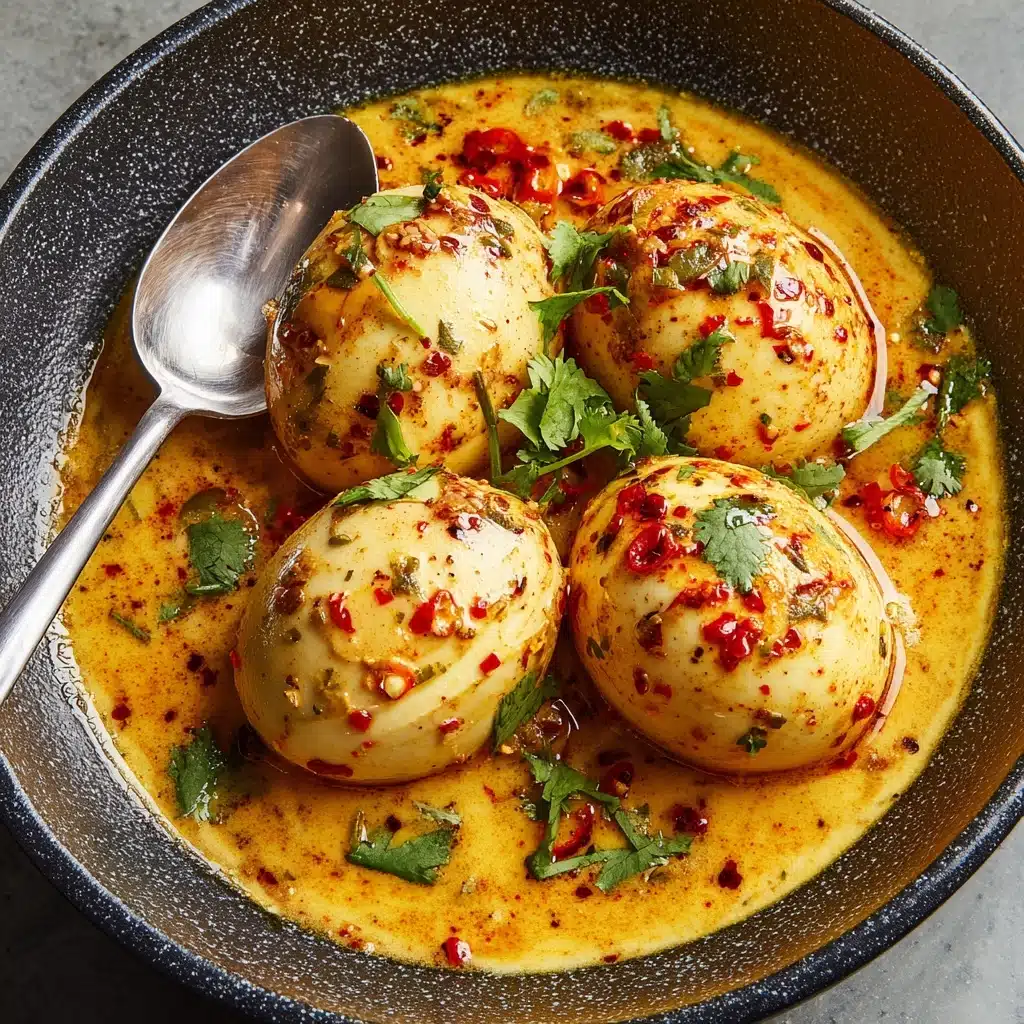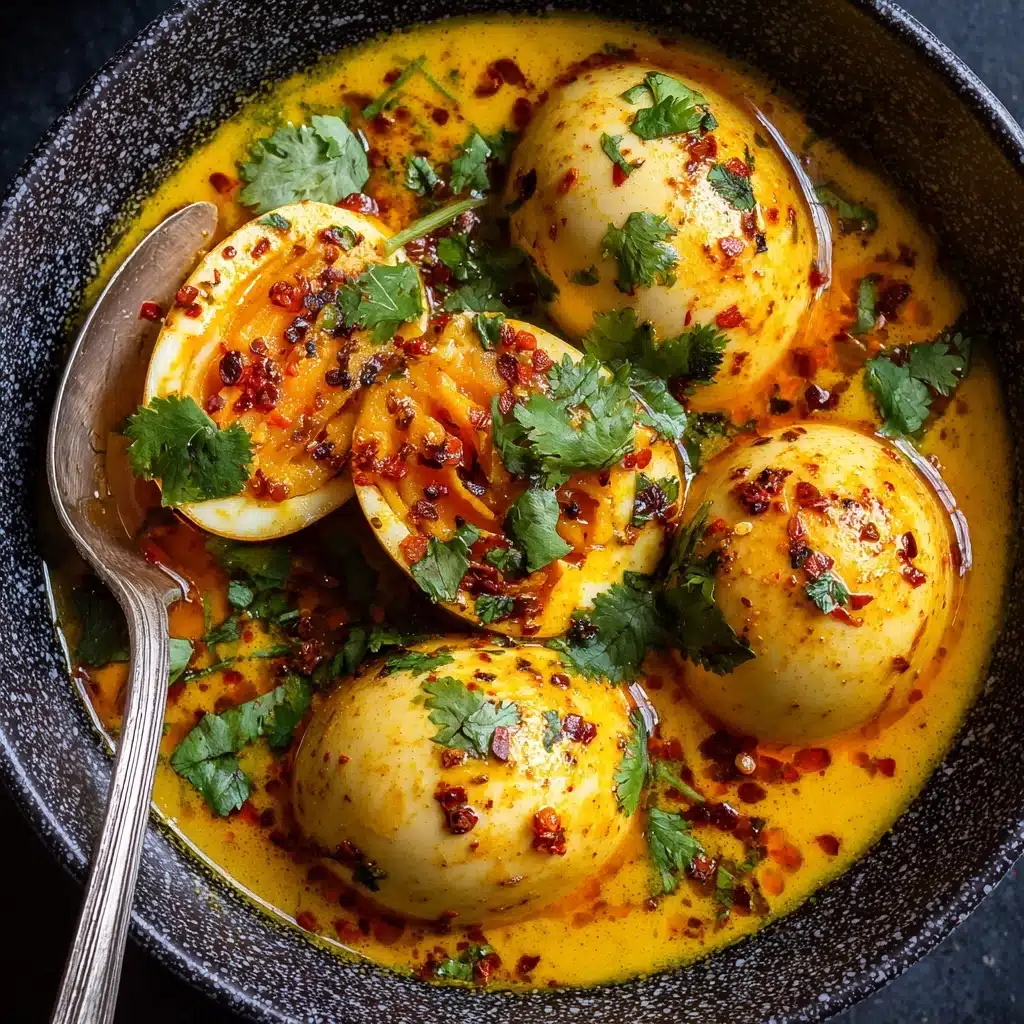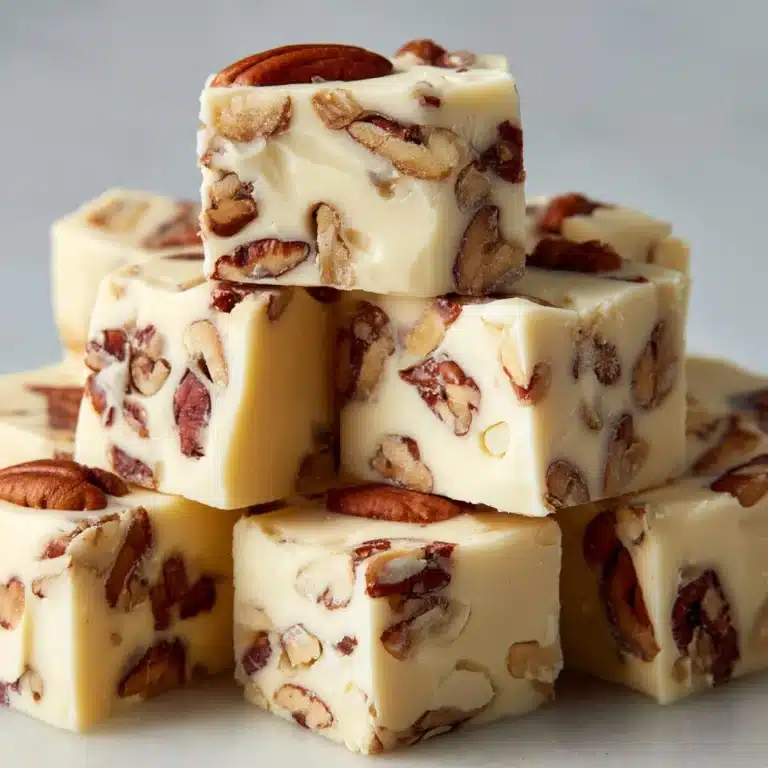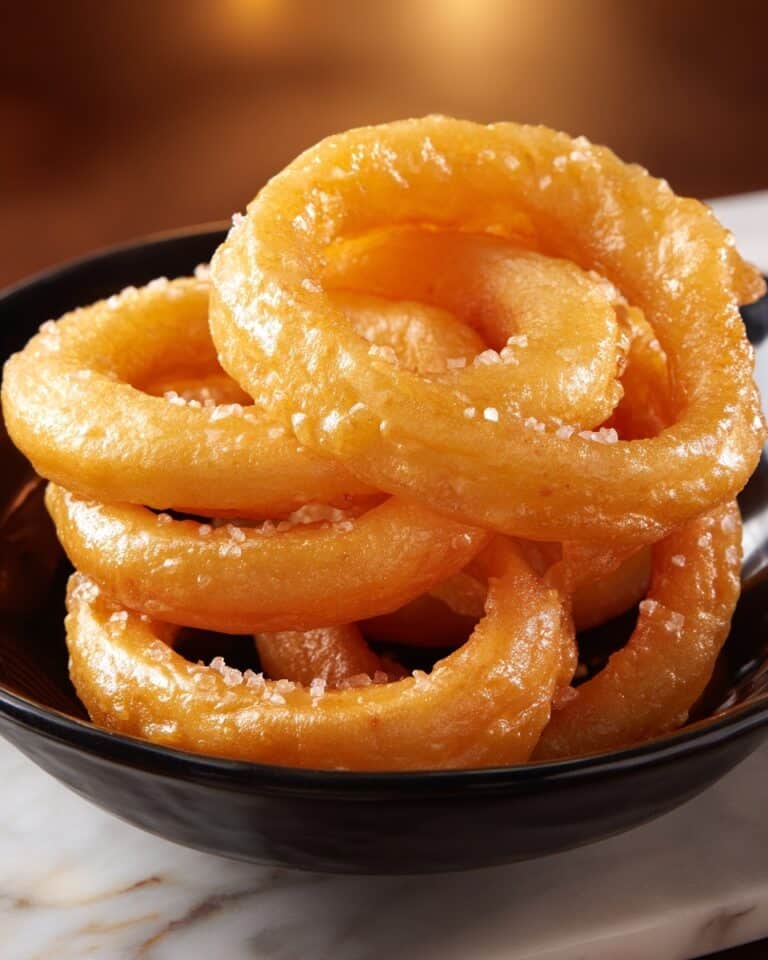Sri Lankan Egg Curry Recipe
If you’re ready to bring a burst of bold flavor to your kitchen, Sri Lankan Egg Curry is a must-try dish that will quickly find a spot among your favorites. With its luscious coconut milk base, aromatic spices, and perfectly hard-boiled eggs, this curry offers a comforting, satisfying meal that’s as vibrant as it is easy to prepare. Whether you’re a curry connoisseur or new to Sri Lankan cuisine, you’ll love how every bite is infused with warmth, depth, and just the right amount of heat. It’s the kind of recipe you’ll find yourself craving again and again!

Ingredients You’ll Need
The beauty of Sri Lankan Egg Curry lies in its simple yet essential ingredients—each one plays a crucial role in building layers of flavor, color, and texture. Gather everything below, and you’ll be amazed at how quickly you can transform them into something extraordinary!
- Eggs: Six large eggs, hard-boiled and peeled; they soak up the spices and become the star of the curry.
- Coconut oil or vegetable oil: Two tablespoons to gently sauté your aromatics and bloom the spices.
- Onion: One finely sliced onion brings sweetness and body to the sauce.
- Garlic: Two cloves, minced, for a subtle punch and depth.
- Fresh ginger: A 1-inch piece, grated, adds warmth and a little zing.
- Green chili (optional): One, sliced, for a lovely fresh heat—skip or reduce for a milder curry.
- Mustard seeds: One teaspoon, essential for that signature Sri Lankan flavor and a nutty aroma.
- Curry leaves: Ten to twelve, fresh or dried, infuse the curry with earthy, citrusy notes.
- Ground turmeric: One teaspoon for golden color and gentle spice.
- Curry powder: One tablespoon (Sri Lankan or Madras-style), which forms the foundation of flavor.
- Chili powder: Half a teaspoon (or to taste); adjust for your perfect level of heat.
- Coconut milk: One 14-ounce can brings that classic creamy richness.
- Water: Half a cup to loosen the sauce to a perfect consistency.
- Salt: One teaspoon, or to taste; don’t skimp, it ties everything together.
- Fresh cilantro (optional): For garnish, a burst of color and freshness right before serving.
How to Make Sri Lankan Egg Curry
Step 1: Sizzle the Spices
Start by heating the coconut oil or vegetable oil in a large skillet or saucepan over medium heat. Once it’s shimmering, toss in the mustard seeds. Wait for them to pop and dance—this quick step unlocks their nutty aroma and sets the stage for your curry’s flavor.
Step 2: Sauté the Aromatics
Add the curry leaves, sliced onion, minced garlic, grated ginger, and green chili (if using) to the pan. Sauté everything together until the onions turn soft and beautifully golden, about 5 to 7 minutes. This fragrant mixture is the heart of any good Sri Lankan Egg Curry.
Step 3: Toast the Spices
Sprinkle in the turmeric, curry powder, and chili powder. Stir continuously for another minute, allowing the spices to release their essential oils and deepen in color and flavor. This is where your curry gets its signature warmth and vibrancy.
Step 4: Make the Sauce
Pour in the coconut milk and water, then season with salt. Give everything a good stir and bring the mixture to a gentle simmer. The coconut milk will turn the sauce creamy and slightly sweet, balancing the spices perfectly.
Step 5: Simmer the Eggs
Carefully nestle the hard-boiled eggs into the curry sauce. You can leave them whole for a dramatic look or halve them for more surface area to soak up the flavors. Let the eggs simmer gently for 10 to 12 minutes so they can absorb all those lovely spices. Taste and adjust the salt as needed.
Step 6: Finish and Garnish
Once the sauce is thickened to your liking and the eggs are infused with flavor, turn off the heat. Sprinkle with fresh cilantro if desired, and serve your Sri Lankan Egg Curry piping hot, ready to be enjoyed!
How to Serve Sri Lankan Egg Curry

Garnishes
A handful of freshly chopped cilantro or a sprinkle of sliced green chilies right before serving brings a pop of color and freshness to your Sri Lankan Egg Curry. If you’re feeling adventurous, a squeeze of lime or a few crispy fried curry leaves can also add a delightful finishing touch.
Side Dishes
This curry is perfect alongside fluffy steamed rice, warm roti, or soft naan—these sides soak up the rich, spiced sauce beautifully. For something extra, serve it with a fresh cucumber salad or a simple lentil dal to create a complete Sri Lankan feast.
Creative Ways to Present
For a fun twist, serve your Sri Lankan Egg Curry in individual bowls with toasted coconut sprinkled on top, or slice the eggs and layer them over the rice before spooning the sauce. It’s also wonderful as a filling for wraps or tucked into flatbreads for a portable meal that’s bursting with flavor.
Make Ahead and Storage
Storing Leftovers
Let your curry cool completely before transferring it to an airtight container. Stored in the fridge, Sri Lankan Egg Curry will keep well for up to 3 days. The flavors actually deepen over time, so leftovers can taste even better!
Freezing
You can freeze Sri Lankan Egg Curry, though the texture of eggs might change slightly after thawing. For best results, freeze the sauce and eggs separately in freezer-safe containers for up to one month. When ready to eat, thaw overnight in the fridge.
Reheating
To reheat, place the curry in a saucepan over low to medium heat, stirring occasionally until warmed through. If it seems too thick, add a splash of water or coconut milk to loosen the sauce. Avoid microwaving for too long, as eggs can become rubbery.
FAQs
Can I make this curry vegan?
Absolutely! Swap the eggs for cubes of firm tofu or hearty vegetables like potatoes or cauliflower. The creamy coconut sauce and spices will still shine, giving you a delicious vegan Sri Lankan curry.
Is it necessary to fry the boiled eggs before adding them?
It’s not required, but lightly frying the boiled eggs until golden gives them a wonderful texture and helps them hold up in the sauce. If you’re short on time, you can skip this step and the curry will still be delicious.
What kind of curry powder should I use?
A Sri Lankan curry powder is ideal for authentic flavor, but Madras-style curry powder works well too. Look for one with a robust blend of spices—if you like things spicy, choose a hotter blend!
Can I use light coconut milk instead of full-fat?
Yes, you can use light coconut milk to reduce calories, but the sauce will be less creamy and rich. For the best flavor and texture, full-fat coconut milk is the way to go for Sri Lankan Egg Curry.
How spicy is Sri Lankan Egg Curry?
The heat level is adjustable! The green chili and chili powder give it a gentle kick, but you can easily tone it down or dial it up. Taste as you go and adjust the spice to suit your preference.
Final Thoughts
If you’re looking to add something new and deeply flavorful to your dinner rotation, don’t hesitate to try Sri Lankan Egg Curry. It’s comforting, quick to make, and guaranteed to impress anyone who loves a good curry. Gather your ingredients, follow these steps, and enjoy every delicious, aromatic bite!
Print
Sri Lankan Egg Curry Recipe
- Total Time: 35 minutes
- Yield: 4 servings 1x
- Diet: Vegetarian
Description
A flavorful and rich Sri Lankan Egg Curry made with hard-boiled eggs simmered in a creamy coconut milk sauce infused with aromatic spices like turmeric, curry powder, and curry leaves. This vegetarian and gluten-free dish balances heat and creaminess, perfect for serving with rice or flatbread.
Ingredients
Eggs
- 6 large eggs, hard-boiled and peeled
Spices & Aromatics
- 1 tsp mustard seeds
- 10–12 curry leaves (fresh or dried)
- 1 tsp ground turmeric
- 1 tbsp curry powder (Sri Lankan or Madras-style)
- 1/2 tsp chili powder (adjust to taste)
Vegetables & Herbs
- 1 onion, finely sliced
- 2 cloves garlic, minced
- 1-inch piece fresh ginger, grated
- 1 green chili, sliced (optional)
- Fresh cilantro (optional, for garnish)
Liquids & Oils
- 2 tbsp coconut oil or vegetable oil
- 1 (14 oz) can coconut milk
- 1/2 cup water
Seasoning
- 1 tsp salt (or to taste)
Instructions
- Heat the oil and toast spices: Heat the coconut or vegetable oil in a large skillet or saucepan over medium heat. Add the mustard seeds and let them sizzle until they start popping, about 30 seconds.
- Sauté aromatics: Add the curry leaves, sliced onions, minced garlic, grated ginger, and sliced green chili to the pan. Cook, stirring occasionally, until the onions are soft and lightly golden, about 5 to 7 minutes.
- Add ground spices: Stir in turmeric, curry powder, and chili powder, cooking for about one minute to toast the spices and release their fragrances.
- Add liquids and season: Pour in the coconut milk and water, then add salt to taste. Stir to combine and bring the mixture to a gentle simmer.
- Simmer eggs in curry: Carefully add the hard-boiled eggs, either whole or halved, to the curry sauce. Let them simmer gently for 10 to 12 minutes so the eggs absorb the flavors of the sauce.
- Adjust seasoning and garnish: Taste the curry and adjust salt or chili powder as needed. Garnish with fresh cilantro if desired and serve hot with rice or flatbread.
Notes
- For deeper flavor, lightly fry the boiled eggs until golden before adding them to the curry.
- Use full-fat coconut milk for the creamiest and richest sauce texture.
- This curry can be made ahead and reheated; the flavors improve and intensify over time.
- Prep Time: 10 minutes
- Cook Time: 25 minutes
- Category: Main Course
- Method: Stovetop
- Cuisine: Sri Lankan
Nutrition
- Serving Size: 1 egg with sauce
- Calories: 250
- Sugar: 2 g
- Sodium: 400 mg
- Fat: 20 g
- Saturated Fat: 12 g
- Unsaturated Fat: 6 g
- Trans Fat: 0 g
- Carbohydrates: 6 g
- Fiber: 1 g
- Protein: 10 g
- Cholesterol: 190 mg






